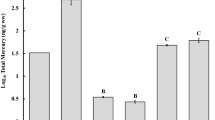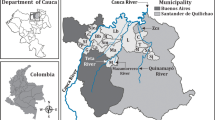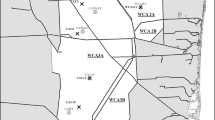Abstract
Mercury is a known neurotoxin and contaminant of concern worldwide. Mercury may occur at elevated concentrations adjacent to industrial sources, such as coal-fired power plants, or in remote environments and newly filled water bodies. Mercury tissue concentrations were determined for a sample of largemouth bass (Micropterus salmoides) from Crystal Reservoir, Ash Meadows National Wildlife Refuge, Nye County, Nevada. This investigation was triggered by (1) the presence of several conditions in soil and water that facilitate mercury bioaccumulation, (2) previous investigations that detected mercury in source springs, and (3) the presence of game fish and endangered pupfish within the reservoir. Mercury concentrations were significantly correlated with both fish mass and condition, but were lower than national human health and safety standards. It is possible that high pH and salinity inhibited methylation and subsequent bioaccumulation; however, additional studies are needed to determine causation of the low concentration in fish tissue compared with ambient conditions.


Similar content being viewed by others
Notes
Conditions such as high hardness and pH are also prevalent, which limit methylation.
The siphon consists of 30.5 and 15.25-cm steel pipes with variable v-valve gates. The 15.25-cm pipe is constant, and the larger pipe is inoperable but is intended to be used in emergency situations. The maximum flow in this pipe is 19.7 cfs at full pool level. The secondary spillway was designed to carry up to 242 cfs.; however, typical export is approximately 0.75 cfs.
References
Abernathy A, Cumbie P (1977) Mercury accumulation by largemouth bass (Micropteres salmoides) in recently impounded reservoirs. Bull Environ Contam Toxicol 17:595–602
Bodaly R, Hecky R, Fudge R (1984) Increases in fish mercury levels in lakes flooded by the Churchill River diversion, Northern Manitoba. Can J Fish Aquat Sci 41:682–691
Brumbaugh W, Krabbenhoft D, Helsel D, Wiener J, Echols K (2001) A national pilot study of mercury contamination of aquatic ecosystems along multiple gradients: bioaccumulation in fish. United States Geological Survey biological report 2001-0009
Cabana G, Tremblay A, Kalff J, Rasmussen J (1994) Pelagic food chain structure in Ontario lakes—a determinant of mercury levels in lake trout (Starvelings namaycush). Can J Fish Aquat Sci 51:381–389
Cizdziel J, Hinners T, Pollard J, Heithmar E, Cross C (2002) Mercury concentrations in fish from Lake Mead, USA, related to fish size, condition, trophic level, location, and consumption risk. Arch Environ Contam Toxicol 43:309–317
Diamond M (1999) Development of a fugacity/aquivalence model of mercury dynamics in lakes. Water Air Soil Pollut 111:337–357
Eisler R (1987) Mercury hazards to fish, wildlife, and invertebrates: a synoptic review. United States Fish and Wildlife Service biological report 85(1.10)
Environmental Protection Agency (2001) Water quality criterion for protection of human health: Methylmercury. Final. Office of Science and Technology, Office of Water, USEPA report EPA-823-R-01-001
Fitzgerald W, Engstrom D, Mason R, Nater E (1998) The case for atmospheric mercury contamination in remote areas. Environ Sci Technol 32:1–7
Jacoub G, Westrich B (2006) Modeling transport dynamics of contaminated sediments in the headwaters of a hydropower plant at the upper Rhine River. Acta Hydrochim Hydrobiol 34:279–286
Krabbenhoft D, Gilmour C, Benoit J, Babiarz C, Andren A, Hurley J (1998) Methylmercury dynamics in littoral sediments of a temperate seepage lake. Can J Fish Aquat Sci 55:835–844
Lodenius M (1983) The effects of peatland drainage on the mercury contents of fish. Suo 34:21–24
Lodenius M, Seppanen A, Herranen M (1983) Accumulation of mercury in fish and man from reservoirs in northern Finland. Water Air Soil Pollut 19:237–246
McKinley P, Long M, Benson L (1991) Chemical analyses of water from selected wells and springs in the Yucca mountain area, Nevada, and southeastern California. United States Geological Survey Open File Report 90-355. USGS, Denver, CO
Nelson W, Campbell P (1991) The effects of acidification on the geochemistry of Al, Cd, Pb, and Hg in freshwater environments: a literature review. Environ Pollut 71:91–130
Perfect D, Faunt C, Steinkampf W, Turner A (1995) Hydrochemical data base for the Death Valley region, California and Nevada. United States Geological Survey Open File Report 94-305. USGS, Denver, CO
Schroeder W, Munthe J, Lindqvist O (1989) Cycling of mercury between water, air, and soil compartments of the environment. Water Air Soil Pollut 48:337–347
Selch T, Hoagstrom C, Weimer E, Duehr J, Chipps S (2007) Influence of fluctuating water levels on mercury concentrations in adult walleye. Bull Environ Contam Toxicol 79:36–40
Smith S, Donahue A, Lipkin R, Blazer V, Schmitt C, Goade R (2002) Illustrated field guide for assessing external and internal anomalies in fish. United States Geological Survey/BRD Information and Technology Report 2002-0007
Stein B, Kutner L, Adams J (eds) (2000) Precious heritage: the status of biodiversity in the United States. Oxford University Press, New York, NY
Suedel B, Boraczek J, Peddicord P, Clifford P, Dillon T (1994) Trophic transfer and biomagnification potential of contaminants in aquatic ecosystems. Rev Environ Contam Toxicol 136:21–89
Toniolo H, Parker G, Voller V (2007) Role of ponded turbidity currents in reservoir trap efficiency. J Hydrol Eng 133:579–595
Weimeyer S (2005) Metals and trace elements in water, sediment, and vegetation at Ash Meadows National Wildlife Refuge—1993. Report by the United States Fish and Wildlife Service, Nevada Field Station
Weiner J, Spry D (1996) Toxicological significance of mercury in freshwater fish. In: Beyer W, Heinz G, Redmon-Norton A (eds) Environmental contaminants in wildlife: interpreting tissue concentrations. CRC Press, Boca Raton, FL, pp 297–339
Acknowledgements
The authors thank the Ash Meadows National Wildlife Refuge and Nevada Department of Wildlife for their assistance in collecting and processing samples. Darrick Weissenfluh assisted necropsies, and Erik Orsak of the Fish and Wildlife Service provided valuable comments on the manuscript.
Author information
Authors and Affiliations
Corresponding author
Rights and permissions
About this article
Cite this article
Goodchild, S., Gerstenberger, S. Mercury Concentrations in Largemouth Bass (Micropterus salmoides) Collected from Ash Meadows National Wildlife Refuge, Nye County, Nevada. Arch Environ Contam Toxicol 60, 496–500 (2011). https://doi.org/10.1007/s00244-010-9565-7
Received:
Accepted:
Published:
Issue Date:
DOI: https://doi.org/10.1007/s00244-010-9565-7




